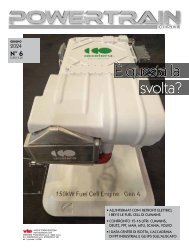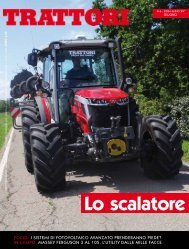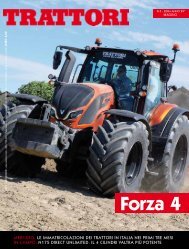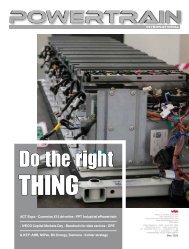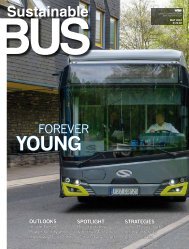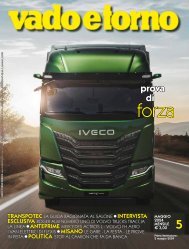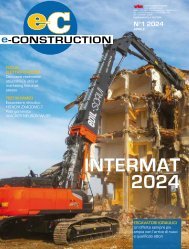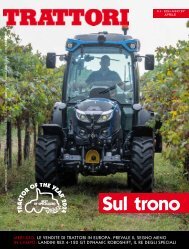SUSTAINABLE BUS 2-2023
Topics? A clear picture of fundings available for zero emission buses in UK, an insight on the fuel cell bus market, a glimpse of the largest electric bus fleet in Middle East (hint: Mowasalat). Again: focus on safety precautions in H2 bus depots, a commentary on the market for second hand e-buses (and battery residual value). Finally: technical presentations of VDL Citea new generation (cover story!), Iveco Bus Crossway LE CNG, Rampini Hydron (and new zero emission bus range)
Topics? A clear picture of fundings available for zero emission buses in UK, an insight on the fuel cell bus market, a glimpse of the largest electric bus fleet in Middle East (hint: Mowasalat). Again: focus on safety precautions in H2 bus depots, a commentary on the market for second hand e-buses (and battery residual value).
Finally: technical presentations of VDL Citea new generation (cover story!), Iveco Bus Crossway LE CNG, Rampini Hydron (and new zero emission bus range)
You also want an ePaper? Increase the reach of your titles
YUMPU automatically turns print PDFs into web optimized ePapers that Google loves.
OUTLOOKS<br />
16<br />
THE ELECTRIFICATION OF PUBLIC TRANSPORT IN QATAR<br />
WORLD CUP<br />
ELECTRIFICATION<br />
We visited the facilities and operations of Middle<br />
East’s leading electric bus fleet. Staggering<br />
numbers, Western standards, ambitious roadmap.<br />
But questions are not missing...<br />
3,000<br />
Buses in<br />
Mowasalat’s fleet<br />
Around 900 e-buses were in operation<br />
in Qatar during the World<br />
Cup, sporting the livery of public<br />
transport company Mowasalat.<br />
That this was the most contested World<br />
Cup ever, and for very good reasons, is<br />
now well known. Exploitation of workers<br />
and corruption are established facts. Less<br />
known, and worthy of interest, is the fleet<br />
electrification effort put in place by the<br />
Doha operator, under government control,<br />
a real large-scale transition experiment to<br />
electric technology. An effort<br />
supported by a massive government<br />
investment, and which<br />
does not fail to raise some questions.<br />
We had the opportunity to visit<br />
the facilities and take a close<br />
look at the operations thanks<br />
to the invitation of the Chinese<br />
manufacturer Yutong, winner<br />
of the maxi tender for 1,002<br />
vehicles (741 electric) issued<br />
by Mowasalat. For the Chinese<br />
group, the world’s leading bus<br />
manufacturer in terms of sales<br />
volumes, this is a first step in<br />
the region: Yutong has signed<br />
a framework agreement with<br />
the Qatar Free Zones Authority<br />
and Mowasalat to establish a KD<br />
factory (a plant where vehicles<br />
destined for a specific market are<br />
assembled) in Qatar that will<br />
serve the entire area. The tender<br />
attracted bids from a dozen builders,<br />
but Mowasalat underlined<br />
that no Western builder has expressed<br />
interest in the electric lot. Price<br />
certainly matters, but that’s not all: there<br />
An estimate of the cost<br />
per km, in a country where<br />
diesel costs €0.50 per<br />
litre and electricity €0.03<br />
per kWh? An e-kilometre<br />
costs one fifth of a fossil<br />
kilometre. It is a pity that<br />
the electric kilometre today<br />
is itself ‘fossil powered’...<br />
is no European manufacturer capable of<br />
guaranteeing a similar production volume.<br />
Let’s not talk about third world models: the<br />
E11s delivered to Doha are identical to the<br />
models in service, about a hundred, in Bergen,<br />
Norway. With the addition of some<br />
specifications, including enhanced air conditioning<br />
in order to accept the challenge<br />
of a region where temperatures above 40<br />
degrees are the norm for most of the year.<br />
Mowasalat: the fleet<br />
To begin, a picture of the Mowasalat fleet.<br />
Over 3,000 vehicles, of which 909 are<br />
electric: a third of the total. The latter are<br />
mainly signed by Yutong, plus a part of<br />
vehicles under the Asiastar logo. The e-<br />
buses cover several mission profiles: the<br />
main slice is made up of the 772 Class I,<br />
of which 91 are less than 9 meters long. 46<br />
school buses (out of a total of over 2,000),<br />
70 high-floor intercity buses and 21 articulated<br />
buses used on BRT services still operate<br />
in electric mode. Curiously there are<br />
few gas-powered buses (170), if one thinks<br />
of the importance of the Gulf state as a player<br />
in the energy market (in 2021, imports<br />
from Qatar covered 24 percent of the LNG<br />
used in the European Union).<br />
17




